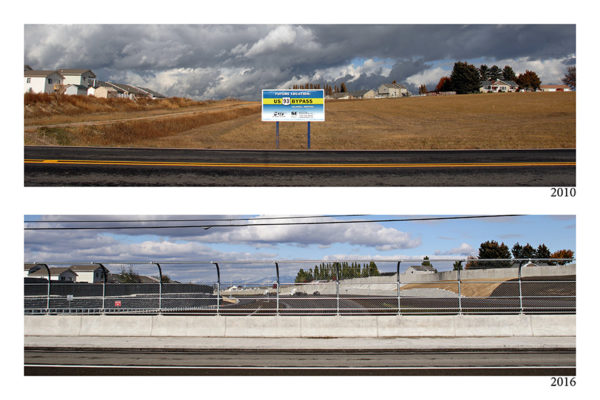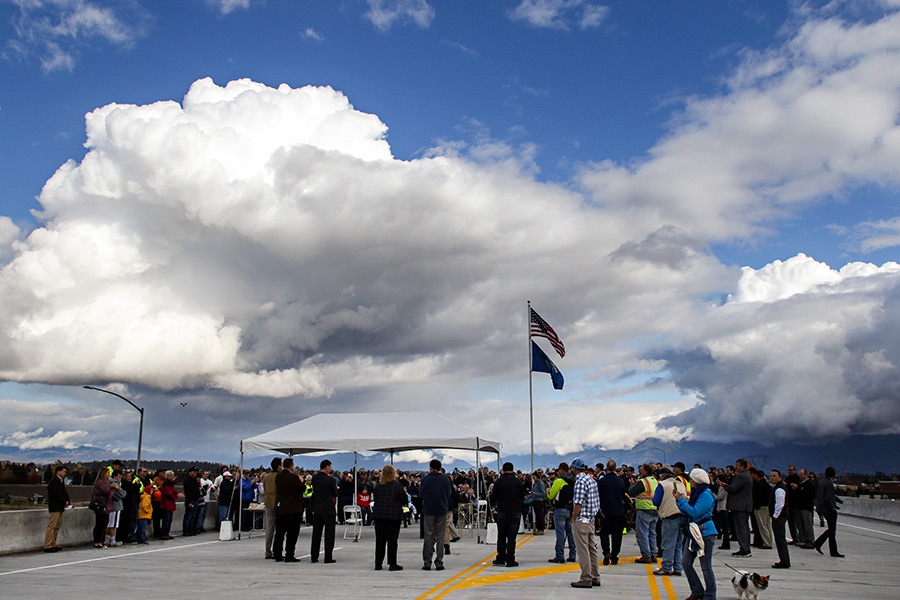Following a procession of local, state and federal dignitaries, the first vehicles streamed onto the black pavement of the onramp at Reserve Loop Drive on Friday afternoon, accessing the new section of the U.S. 93 Alternate Route and arriving at a community milestone several decades in the making.
The Kalispell bypass — the single largest highway transportation project in Montana history and a community aspiration dating back 70 years — is finally whole and open.
Four lanes of new highway, accompanied by a pathway for cyclists and pedestrians, now flow past burgeoning neighborhoods along the bustling north end of Kalispell and connect with the existing two-lane south half at U.S. Highway 2.
Nearly 150 people gathered Oct. 28 on one of the five new bridges along the highway route to celebrate the opening of the historic infrastructure project. In the midst of the wettest October in Kalispell’s history, even the skies parted momentarily and sunlight brightened the shine of new pavement.
“This has been a long time coming,” Kalispell Mayor Mark Johnson said. “I’m excited to see what it does for Kalispell and the future of the Flathead Valley.”
The future impact of the full-fledged bypass remains to be seen. Will it relieve traffic congestion on Main Street? Will it help or hinder downtown businesses?
Questions linger, but this much is undeniable: the bypass paved the way for much more than highway lanes and overpasses.
It bolstered the local economy. Nearly $140 million was invested in the bypass in the last decade and millions more in new development have surfaced around the massive transportation project, which has largely reshaped the city’s transportation grid and opened the door for possible improvements on Main Street.
“The long-term benefits for the economy are already beginning to show, from the new housing developments on the south end to numerous retail developments here on the north end,” Gov. Steve Bullock said Friday.
“The completion of the bypass also gives the Kalispell downtown area a big opportunity to continue its revitalization efforts as the heartbeat of this vibrant community.”
It created jobs. Most recently, LHC, a Kalispell-based contractor, was awarded the $34 million bid to develop the final 4.5-mile north half. The local company employed more than 160 workers and hired 16 locally-based subcontractors to complete the project ahead of schedule.
“We should all be excited about it,” Jeff Claridge, a fourth-generation Kalispell native who owns LHC, said.
“It’s not very often that you get a project that comes along that has an immediate impact like this one.”
The bypass brought Democrats and Republicans together at all levels of government, working to achieve something the community desperately wanted for generations. Former U.S. Sen. Max Baucus acquired initial federal transportation funding to get the project off the ground and in the ensuing years fellow Montana Sens. Conrad Burns, Jon Tester, Steve Daines and Reps. Denny Rehberg and Ryan Zinke played roles in gaining further financial support.
“When I grew up (in Whitefish), Kalispell was the heart of the valley. Downtown Kalispell has gone through some periods where it needs some help. This bypass allows the next step. It allows Kalispell to retake its place,” Zinke said.
“This is what happens when both sides come together.”
Tester, who helped Kalispell also land a $10 million transportation grant a year ago to revitalize downtown and build an industrial rail park, described the projects as transformative for the community.
“Between that Glacier Rail Yard project and this Kalispell bypass, these kinds of investments are going to change Kalispell for the better for generations to come and make your economic future very, very bright in regards to good paying jobs and quality of life,” Tester said.
Building the bypass represented the tireless efforts of local community planners, such as Kalispell Planning Director Tom Jentz and Kathy Harris at KLJ, who both crafted the intricate details of the route, and state transportation officials who dedicated large portions of their careers to shepherding the largest project in state history.
“It brings tears to my eyes. It’s been my whole life for several years,” said Jim Mitchell, the Montana Department of Transportation’s engineering project manager for the bypass over the last 10 years.
After 40 years with MDT, Mitchell is retiring with the completion of the bypass, an occasion he celebrated Friday with his children and grandchildren.

MDT director Mike Tooley applauded the efforts of Mitchell and other MDT staff who stuck with it and built solid relationships with city leaders and community members to create a project that would benefit all.
“The community should be rightfully proud,” Tooley, who helped make the bypass a state priority in recent years, said.
Tooley said there are not any immediate plans to expand the south portion to four lanes with two overpasses.
“It will happen someday, but down the road.”
MDT officials said the initial speed limit along the route will be 55 mph and future traffic studies could lead to increases.
Ed Toavs, a Columbia Falls native and the regional administrator for MDT, played a pivotal role in pushing the bypass toward completion, particularly by bundling the final north half in one bid, the single largest contract in state history, which reduced the remaining estimated cost by $9 million.
“It’s real satisfying to be involved in a project of this magnitude,” Toavs said. “It’s a neat thing from the perspective of moving a community forward.”
Former mayors, such as Tammi Fisher, Pam Carbonari and Doug Rauthe, and county leaders such as administrator Mike Pence, helped keep the project moving forward with support and initiative.
“This has been going on ever since I was a boy,” Rauthe said, recalling talks of a truck bypass for Kalispell dating back to the 1940s and 50s. “It went on for so long, I thought it probably won’t get built in my lifetime.”
Building the bypass even built families. Fisher, who was an outspoken proponent of the project when she was mayor, met her future husband, Don Brummel, the project manager for LHC, while touring the site years ago.
“I joked with friends, ‘I’ll do anything to get this bypass built,” she said Friday, laughing and smiling with Brummel after taking a family photo on the empty road.
The significance of building the bypass stretches beyond 7.6 miles of pavement.
As Sen. Daines said in a letter read at Friday’s ceremony, “This is so much more than a road. This is historic.”
